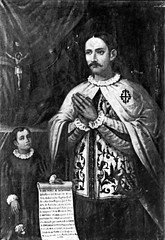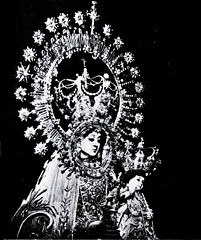Both father and son served as Gobernador y Capitán General of the Philippines. The former from 1590 to 1593 and the latter, 1593 to 1596.

The man behind the icon. Luis Pérez Dasmariñas.
Under the direction of a Spanish captain, Don Hernando de los Rios Coronel, the pagan Chinese craftsman from Ilocos created a "native" Virgin. A virgin whose countenance reflected her country's beauty.

Almond eyes, high cheekbones and full lips, features that distinguish the Virgin of Smo. Rosario de La Naval from other Marian images in the Philippines.
The icon of the Madonna and Child, Luis had ordered to be rendered, would later become famously known as the Nuestra Senora del Santisimo Rosario de La Naval de Manila.

The wood and ivory statue is credited with numerous miracles. Perhaps the most famous of which, and why the "La Naval" was added to the Virgin's appellation, was the miraculous victory of the La Naval de Manila in 1646.
In the early 1600s, the Spanish colony of Manila soon found herself part of the Eighty years War that had started back in 1548 due to the Dutch Revolt against the King of Spain.
Earlier naval battles with the Dutch in the waters of the Philippines, resulted in Spanish victories. In 1646, however, Eighteen Dutch warships were sent to Manila to attack the colony and the city had nothing but two galleons, Encarnación and Rosario, to defend herself. In five succeeding battles, the small Spanish-Filipino armada, mostly manned by Filipino natives, fought and won over the Dutch mighty naval fleet. The unlikely victory is credited with the Virgin of Rosary, particularly with this "Native looking" statue of the Virgen.

In the coming centuries, the Virgin's popularity and miracles attributed to it, grew. In 1907, the Virgin was canonically crowned. The first image of the Virgin in the Philippines, and in Asia, to be given with such an honor. During WWII, the Virgin miraculously escaped the destruction of her temple in Manila.





0 comments:
Post a Comment